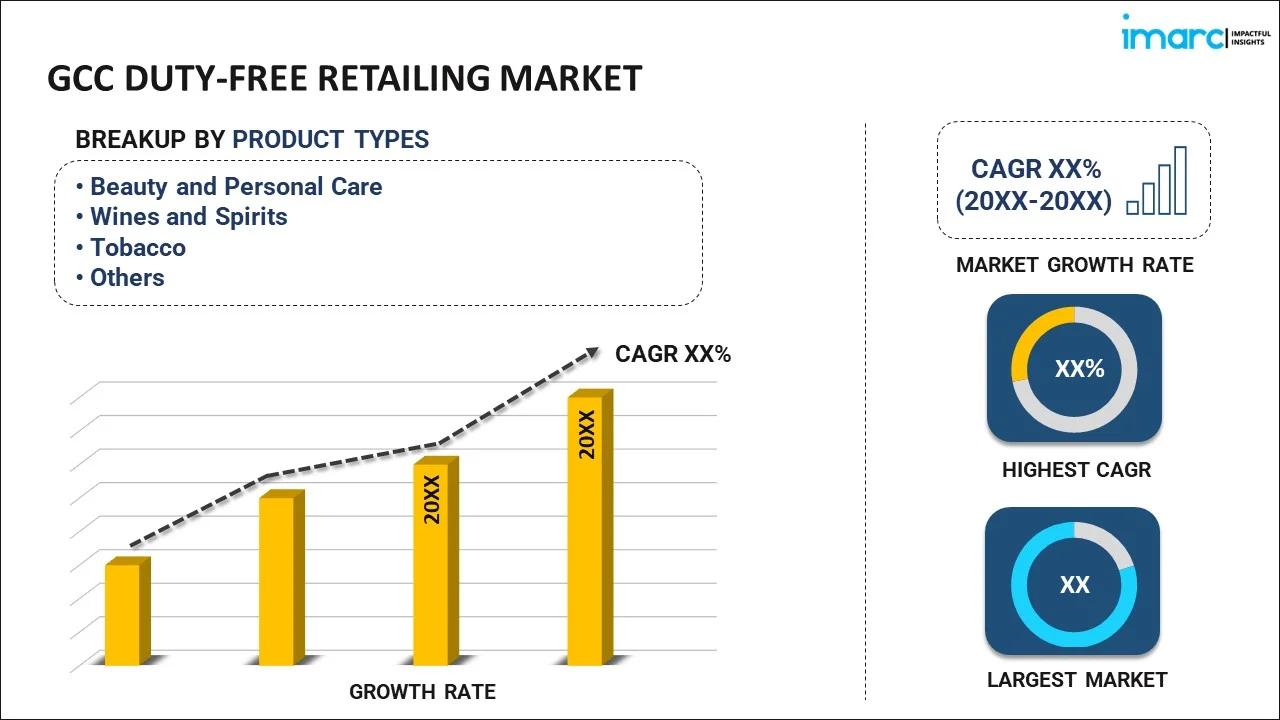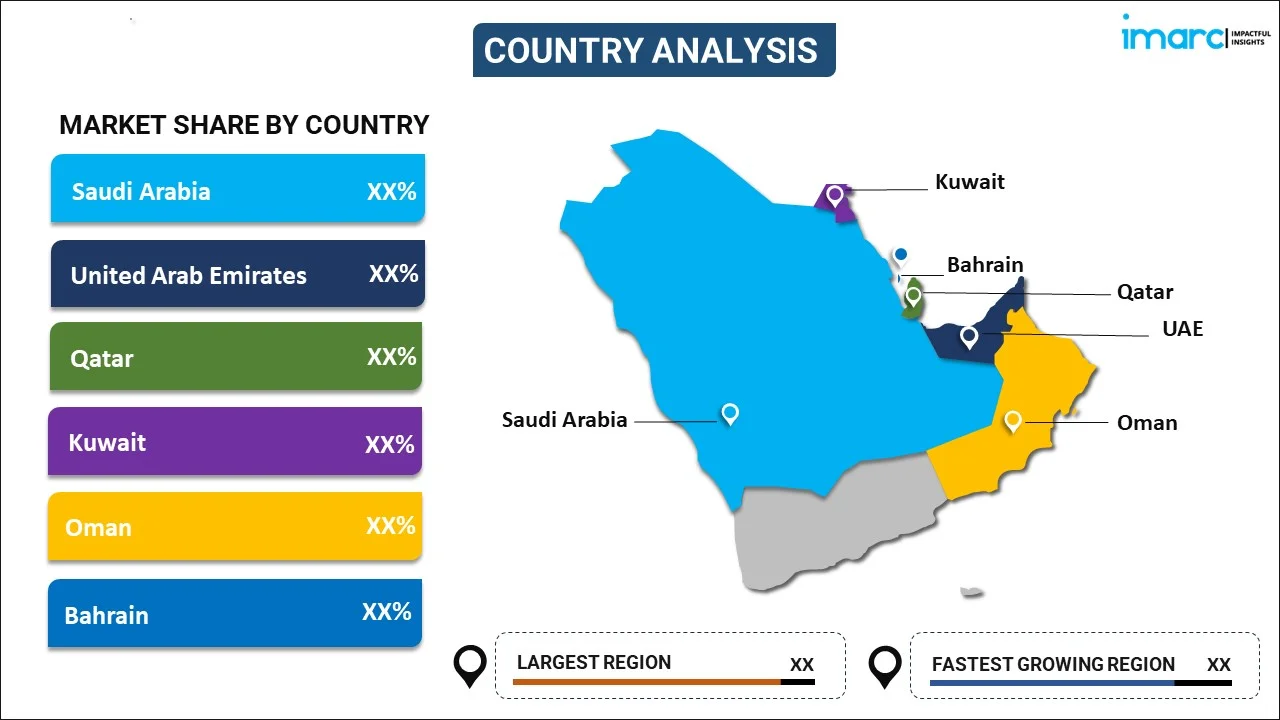
GCC Duty-Free Retailing Market Report by Product Type (Beauty and Personal Care, Wines and Spirits, Tobacco, Eatables, Fashion Accessories and Hard Luxury, and Others), Distribution Channel (Airports, Airlines, Ferries, and Others), and Country 2025-2033
Market Overview:
The GCC duty-free retailing market size reached USD 1.6 Billion in 2024. Looking forward, IMARC Group expects the market to reach USD 3.9 Billion by 2033, exhibiting a growth rate (CAGR) of 9.77% during 2025-2033. The flourishing tourism industry in the GCC region, rapid expansion of airports and seaports, growing expenditure capacities of regional consumers, imposition of supportive regulations and policies by regional governments, and rising adoption of digital payment methods represent some of the key factors driving the market.
|
Report Attribute
|
Key Statistics
|
|---|---|
|
Base Year
|
2024 |
|
Forecast Years
|
2025-2033 |
|
Historical Years
|
2019-2024
|
| Market Size in 2024 | USD 1.6 Billion |
| Market Forecast in 2033 | USD 3.9 Billion |
| Market Growth Rate (2025-2033) | 9.77% |
Duty-free retailing refers to a specialized retail environment where goods are sold without the inclusion of local import duties, taxes, or tariffs. It includes merchandise stores, luxury boutiques, liquor and tobacco shops, confectionery stores, and electronics outlets, each catering to different consumer preferences. These retailing businesses are primarily located at international airports, seaports, and border crossings where travelers can purchase products in a tax-free zone. Duty-free retailing finds a wide range of applications across multiple sectors, including travel, tourism, aviation, maritime transport, and border trade. It offers various benefits such as cost savings for consumers, increased revenue for retailers, stimulation of local economies, and convenience for international travelers. Duty-free shopping also aids in enhancing customer loyalty, increasing airport footfall, improving traveler experience, contributing to national tourism, boosting brand visibility, offering quality assurance, providing luxury shopping experience, reducing the total cost of travel, promoting bulk purchasing, and attracting high-value customers.
GCC Duty-Free Retailing Market Trends:
The flourishing tourism industry in the GCC region, which boosts footfall in airports and other duty-free zones, is propelling the market growth. In addition, the rapid expansion of airports and seaports, owing to the heavy investment in infrastructural development activities, is boosting the market growth. Furthermore, the growing expenditure capacities of regional consumers, which is creating a robust customer base willing to indulge in luxury shopping, is acting as another growth-inducing factor. Besides this, the increasing number of diverse and international clientele due to the region's strategic location as a crossroads between East and West is further bolstering the market growth. Additionally, the imposition of various supportive policies and regulations by regional governments to ease retail and trade regulations and provide a conducive environment for duty-free shopping is contributing to the market growth. Apart from this, the rising adoption of digital payment methods, which enhance user convenience and facilitate easier transactions, is fueling the market growth. Moreover, the escalating partnerships between retailers and airlines offering added incentives and discounts to draw more customers to duty-free stores are positively impacting the market growth. Along with this, the emerging trends of offering culturally tailored and localized products are catalyzing the market growth. In addition, the heightened awareness about the benefits of duty-free shopping among the middle-class population, coupled with the availability of exclusive products, is strengthening the market growth. Furthermore, the escalating demand for sustainable and eco-friendly duty-free products among environmentally conscious consumers is supporting the market growth.
GCC Duty-Free Retailing Market Segmentation:
IMARC Group provides an analysis of the key trends in each segment of the GCC duty-free retailing market report, along with forecasts at the regional and country levels for 2025-2033. Our report has categorized the market based on product type and distribution channel.
Product Type Insights:

- Beauty and Personal Care
- Wines and Spirits
- Tobacco
- Eatables
- Fashion Accessories and Hard Luxury
- Others
The report has provided a detailed breakup and analysis of the market based on the product type. This includes beauty and personal care, wines and spirits, tobacco, eatables, fashion accessories and hard luxury, and others.
Distribution Channel Insights:
- Airports
- Airlines
- Ferries
- Others
A detailed breakup and analysis of the market based on the distribution channel has also been provided in the report. This includes airports, airlines, ferries, and others.
Country Insights:

- Saudi Arabia
- UAE
- Qatar
- Bahrain
- Kuwait
- Oman
The report has also provided a comprehensive analysis of all the major regional markets, which include Saudi Arabia, UAE, Qatar, Bahrain, Kuwait, and Oman.
Competitive Landscape:
The report has also provided a comprehensive analysis of the competitive landscape in the market. Competitive analysis such as market structure, key player positioning, top winning strategies, competitive dashboard, and company evaluation quadrant has been covered in the report. Also, detailed profiles of all major companies have been provided.
GCC Duty-Free Retailing Market Report Coverage:
| Report Features | Details |
|---|---|
| Base Year of the Analysis | 2024 |
| Historical Period | 2019-2024 |
| Forecast Period | 2025-2033 |
| Units | Billion USD |
| Scope of the Report | Exploration of Historical and Forecast Trends, Industry Catalysts and Challenges, Segment-Wise Historical and Predictive Market Assessment:
|
| Product Types Covered | Beauty and Personal Care, Wines and Spirits, Tobacco, Eatables, Fashion Accessories and Hard Luxury, Others |
| Distribution Channels Covered | Airports, Airlines, Ferries, Others |
| Countries Covered | Saudi Arabia, UAE, Qatar, Bahrain, Kuwait, Oman |
| Customization Scope | 10% Free Customization |
| Post-Sale Analyst Support | 10-12 Weeks |
| Delivery Format | PDF and Excel through Email (We can also provide the editable version of the report in PPT/Word format on special request) |
Key Questions Answered in This Report:
- How has the GCC duty-free retailing market performed so far and how will it perform in the coming years?
- What has been the impact of COVID-19 on the GCC duty-free retailing market?
- What is the breakup of the GCC duty-free retailing market on the basis of product type?
- What is the breakup of the GCC duty-free retailing market on the basis of distribution channel?
- What are the various stages in the value chain of the GCC duty-free retailing market?
- What are the key driving factors and challenges in the GCC duty-free retailing market?
- What is the structure of the GCC duty-free retailing market and who are the key players?
- What is the degree of competition in the GCC duty-free retailing market?
Key Benefits for Stakeholders:
- IMARC’s report offers a comprehensive quantitative analysis of various market segments, historical and current market trends, market forecasts, and dynamics of the GCC duty-free retailing market from 2019-2033.
- The research study provides the latest information on the market drivers, challenges, and opportunities in the GCC duty-free retailing market.
- Porter's five forces analysis assist stakeholders in assessing the impact of new entrants, competitive rivalry, supplier power, buyer power, and the threat of substitution. It helps stakeholders to analyze the level of competition within the GCC duty-free retailing industry and its attractiveness.
- Competitive landscape allows stakeholders to understand their competitive environment and provides an insight into the current positions of key players in the market.
Need more help?
- Speak to our experienced analysts for insights on the current market scenarios.
- Include additional segments and countries to customize the report as per your requirement.
- Gain an unparalleled competitive advantage in your domain by understanding how to utilize the report and positively impacting your operations and revenue.
- For further assistance, please connect with our analysts.
 Inquire Before Buying
Inquire Before Buying
 Speak to an Analyst
Speak to an Analyst
 Request Brochure
Request Brochure
 Request Customization
Request Customization




.webp)




.webp)












